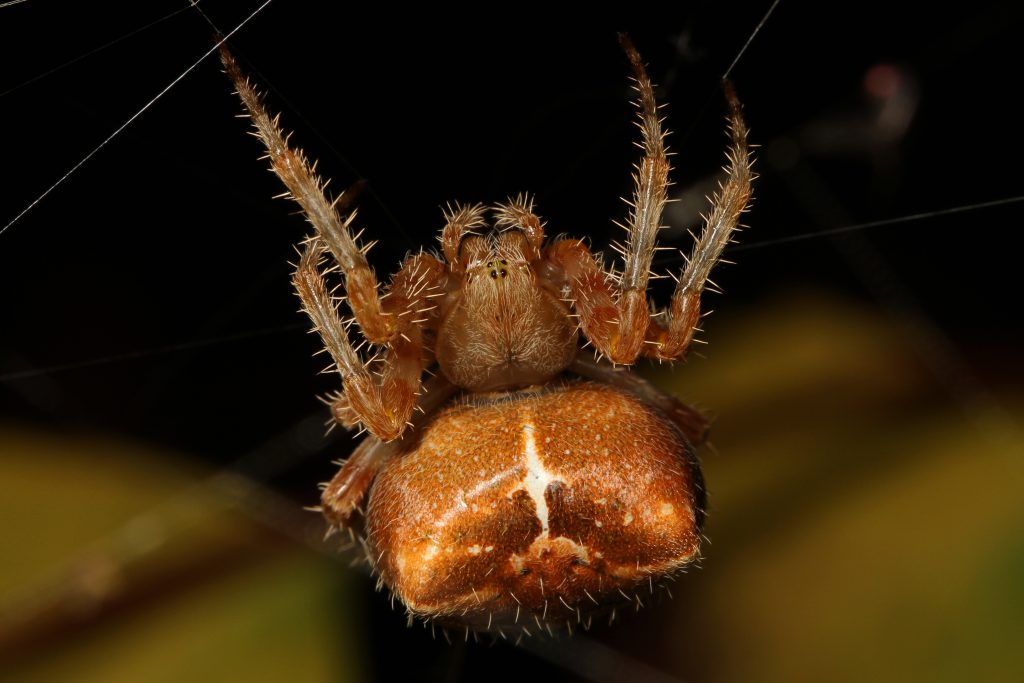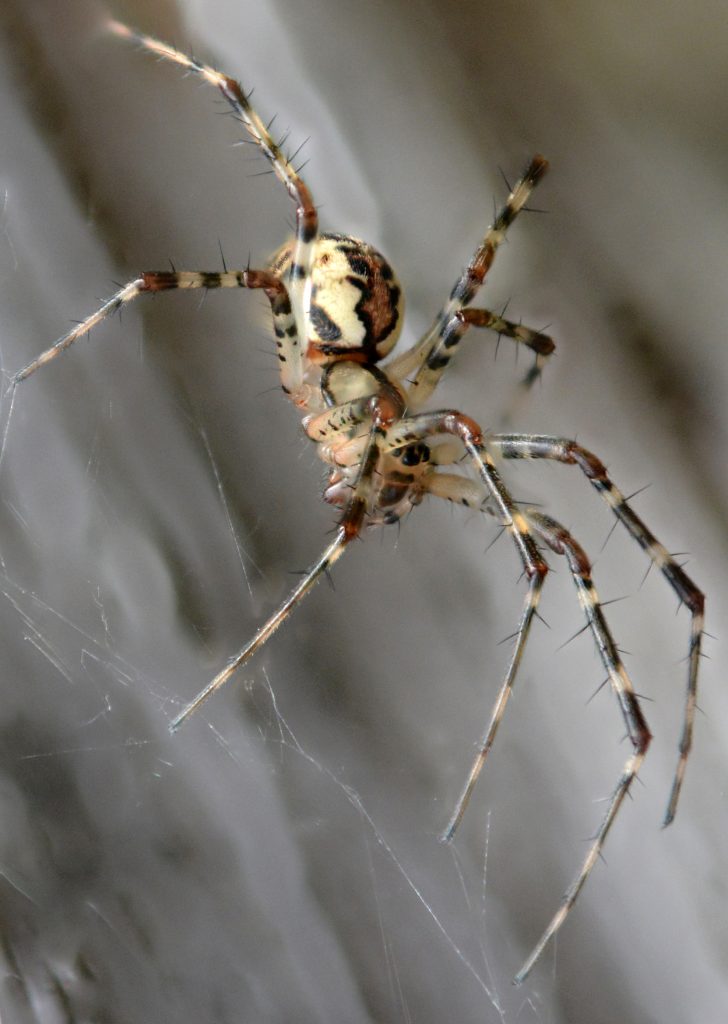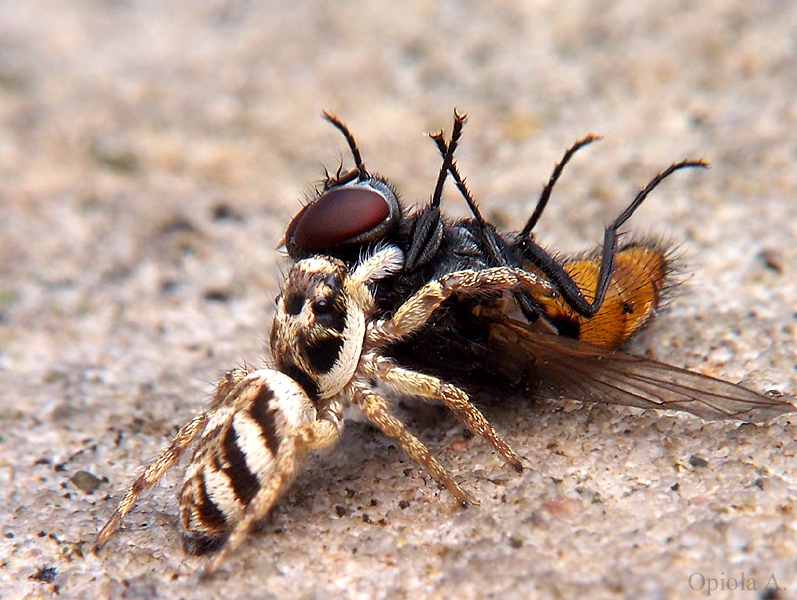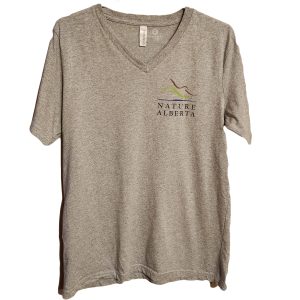Spiders: The Misunderstood Jewels of Alberta’s Biodiversity

The cat-faced orbweaver (Araneus gemmoides) is a native species, commonly found in urban areas. This species is normally seen building their orb webs in backyards, window frames, and fences. JUDY GALLAGHER
BY JAIME PINZON
Our relationship with animals that use venom, either to hunt or to avoid being eaten, is quite complex. After all, self-preservation is rooted in our very core! Thus, venomous animals provoke strong reactions of fear in many people, and spiders are perhaps near the top of the most dreaded list. Even if you are not a full-blown arachnophobe, you may not feel comfortable with the thought of sharing space with them. (Spoiler alert: very likely a spider is watching you read this!)
With a little bit of positive experience and a better understanding about their fascinating lives, many can overcome their fear of spiders. I have witnessed terrified students of mine turn into spider-loving individuals after just a few weeks of being exposed to them while conducting field work. While I do not expect this article to turn you into an arachnophile, I do hope it will help you to tolerate them, and perhaps even appreciate them.
Spider Diversity
Spiders have populated the Earth since the mid-Devonian Period, 380 million years ago, long before the dinosaurs came on the scene. Their general body plan — a fused head and thorax with four pairs of legs, an abdomen with silk-spinning organs near the end, no wings, and no antennae — hasn’t changed much over the eons. In fact, there is a group of spiders still crawling around in the forests of southeast Asia today that retain ancestral characters, including a segmented abdomen with spinning organs in the middle. They look pretty much like those from the Devonian Period and are considered living fossils.
Spiders are a highly diverse group, with over 50,000 species described so far and more than 1,400 species in the fossil record. Alberta has its own fossil spider named Orchestina albertensis. This 1-mm-long, late Cretaceous spider was described from a specimen preserved in a piece of amber found close to the hamlet of Grassy Lake.
Except for Antarctica, spiders can be found on every terrestrial ecosystem on Earth, from deep caves to near the top of Mount Everest (a jumping spider has been found thriving at 6,700 m). Our local spider fauna is very well adapted to Alberta’s long, cold winters. While many spiders overwinter as eggs within a protective egg sac, other species remain active under the snowpack all winter thanks to antifreeze compounds in their “blood.” Next time you are snowshoeing on a warm and sunny winter day, keep your eyes open and you may see spiders crawling on the snow!
Spiders are also found in aquatic environments. One species, the diving bell spider, lives almost entirely submerged underwater inside a bell-shaped web. The spider fills this web with air trapped by hairs on its body when it comes to the surface. The diving bell spider is not found in Alberta, but we do have a very diverse community of spiders associated with wetland areas. Two species, the striped fishing spider and the six-spotted fishing spider, are common inhabitants of ponds, bogs, and fens. Although they do not live underwater like the diving bell spider, females carrying egg sacs can spend long periods of time below the surface, either to regulate the temperature of their precious cargo or to protect it from predators.

The taiga sheetweb weaver (Pityohyphates subarcticus) is one of the larger species within the sheetweaver group and their sheet webs are quite common in shrubby vegetation along trails. J. ROBERTIA
Natural History
Most spiders are exclusively carnivorous and prey primarily on invertebrates (mostly insects and other arachnids). Some species occasionally prey on small vertebrates as well, including mammals, frogs, birds, snakes, and fish. Though it is not commonly known, some spiders supplement their carnivorous diet with nectar, sap, and pollen.
Spiders have evolved to subsist entirely on a liquid diet. When they capture their prey, spiders regurgitate enzymes over and inside it, turning it into a nutritious, partly digested soup that is sucked in by a powerful stomach pump. Many species, such as the shamrock orbweaver, grind and masticate their prey, whereas others, such as the goldenrod crab spider, liquefy the insides, leaving behind an empty husk. (Anybody hungry?)
Spiders are perhaps the most abundant predators in terrestrial ecosystems, playing a very important role in regulating populations of other bugs (and also serving as prey for many other species). Estimates suggest a density of 130–150 spiders per square metre in natural habitats, which works out to a weight of 25 million metric tonnes globally and a prey kill of 400–800 tonnes per year.1 That is a lot of mosquitoes and other bugs! Although these are estimated values, they bring a heavy truth. If spiders ceased to exist, the ecological, environmental, and social consequences would be devastating, as populations of many insects would explode, including those that feed on our crops and those that can affect our health.
Venom
Most spiders produce venom to kill or paralyze their prey, though there are a few species that lack venom glands. This does not mean that all spiders are dangerous to humans. Most spiders are too small for their fangs to be able to puncture and penetrate human skin. Moreover, among the several thousands of species described to date, only a handful possess venom potent enough to harm humans. These comprise a couple dozen or so species of medical importance, including black widow spiders, recluse spiders, Australian funnel-web spiders, and armed spiders of Central and South America.
Only one potentially dangerous species, the western black widow, is found in Alberta, usually in dry prairie habitats. If you happen to encounter a western black widow, the likelihood of an unpleasant interaction is small, as these are shy spiders that prefer to flee and rarely bite. If they do bite, they normally will save their costly venom for things they can actually feed on, not you! However, if you suspect a western black widow bite, it is best to seek medical attention, particularly for children and elders. Another notable species of concern is the brown recluse spider. Although it is found in North America, there are no established populations in Alberta and it has not been reported in the province.
Spiders are often blamed for the mysterious “bites” we all get on occasion. But unless you actually see the eight-legged culprit biting you, it’s probably from something else. In most cases, these marks are either from a bloodsucking insect or from bacterial or fungal skin infections, among other non-spider origins. But don’t get me wrong — I am not trying to minimize spider bites. They do happen and can be painful, in some cases equivalent to a bee or wasp sting.
Local Spiders
Alberta is home to 628 species of spiders, representing almost half of those recorded in Canada (over 1,400 species).2 That’s more than the number of bird species we have in the province. This number is destined to grow as we continue to improve our species inventories. For example, a couple dozen more species were added from my research in poorly studied Alberta wetlands.
Despite this great diversity, you are unlikely to encounter more than a small fraction of these species because many of them are either too small (less than 5 mm), have cryptic behaviours, or live in remote habitats. The spiders you are likely to encounter include wolf spiders, jumping spiders, crab spiders, orb weaving spiders, and funnel weaving spiders. These and other groups can be identified using a free, user-friendly resource produced by one of my students.3 These spiders are not single species, but rather groups of species. For instance, there are 47 different species of wolf spiders in Alberta, some of which are commonly observed in open areas, such as fields, forest cutblocks, and yards. The same goes for jumping spiders (40 species), crab spiders (63 species), orb weavers (45 species), and funnel weavers (6 species). If you are one of the thousands of iNaturalist users, you can have a look at the 8,000-plus observations of about 160 spider species commonly seen in Alberta and elsewhere in Canada.
At the top of Alberta’s spider diversity list are the spiders in the Linyphiidae family, which includes the sheetweaver and dwarf spiders. There are 251 reported species in this group and at least 30 more from my research. These are often very small spiders, many of which live on the ground, within grass blades or in the forest leaf litter. Some of the larger species in this group are common inhabitants of the shrub layer and include frequently observed species such as the filmy dome sheetweaver, the doily sheetweaver, and the northern hammock sheetweaver.
While the vast majority of Alberta’s spider species are native to the province, 12 are exotic species that have been able to establish breeding populations.2 Of these, the zebra jumping spider and the barn funnel weaver spider are perhaps the most commonly encountered, particularly in urban areas. Not long ago, we reported the presence of an apparent recent introduction of the harvestman cellar spider in Canada, with Albertan records (north of Acheson) corresponding to the most northern observations of this species in North America. (Despite the common name of this species, note that harvestmen are not spiders but a related group of arachnids, Opiliones).

The zebra jumping spider (Salticus scenicus) is another introduced species observed mostly in urban areas of Alberta. As shown in this photo, many spiders are able to capture prey larger than themselves. ADAM OPIOLA
From a conservation point of view, the status of about 270 native species in Alberta is secure or apparently secure; however, there are four imperiled species (one of which is believed to be endemic to Canada) and five that are vulnerable. Important knowledge gaps exist for the remaining species; their conservation status is currently unknown (that is more than half of the species).2
Although spiders are perhaps not as charismatic to most people as caribou, peregrine falcons, wood frogs, or other iconic species, they contribute to the fragile equilibrium of many ecosystems in our province and across the globe. They deserve their share of this planet as much as every other organism. Spiders may not be your favourite creature, but next time you run into one, think twice before squishing or stepping on it.
References
- Nyffeler, M. and K. Birkhofer (2007) An estimated 400–800 million tons of prey are annually killed by the global spider community. The Science of Nature, 104, 30.
- Canadian Endangered Species Conservation Council (2022). Wild Species 2020: The General Status of Species in Canada. National General Status Working Group: 172 pp.
- Kent, K., J. Pinzon, and H. Proctor (2023). A beginner-friendly key to the spider families (Arachnida: Araneae) known from the Canadian Prairie Provinces (Alberta, Saskatchewan, and Manitoba). Canadian Journal of Arthropod Identifications, 47: 1–72.
Jaime Pinzon is an arachnologist from Colombia who moved to Canada to study spider responses following forest harvesting as part of his PhD at the University of Alberta. He is currently with the Canadian Forest Service in Edmonton, where much of his research focuses on spider ecology and overall biodiversity responses to natural and human disturbances, with particular interest in the context of forest management and land restoration.
This article originally ran in Nature Alberta Magazine – Summer 2023.

